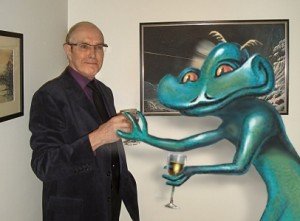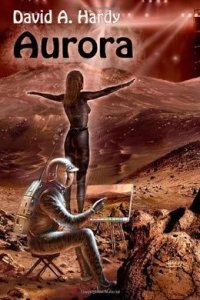David A. Hardy interview.
David A. Hardy is an award winning astronomical artist, European Vice President of the International Association of Astronomical Artists (IAAA), and also VP of the ASFA (Association of Science Fiction & Fantasy Artists) You can see his paintings on www.astroart.org
The interview was conducted by Pauline Morgan.
Pauline Morgan: You are known as a versatile astronomical artist working in a range of media, why did you decide to write a novel?
David A. Hardy: I’ve always written and had many articles on astronomy, space, art, etc published, as well as co-writing books with Patrick Moore and others and my own seven non-fiction books. I’ve written many short stories so, like most writers, I had a novel at the back of my mind for many years. I realised that two of my short stories could be connected, if the baby at the end of the first, which took place in World War 2, could become the girl in the second (which had been published as ‘Rock’ in magazine ‘Orbit’ in 1986). There was an age problem. She would have to be around 30, not a teen-ager, but I found a science-fictional way around that and the rest of the novel then flowed very quickly. In fact, I really had to get it down on paper, as if under some sort of compulsion to do so!
PM: When you had completed ‘Aurora’, how easy was it for you to find a publisher?
DH: I gave it to John Jarrold at a Birmingham SF Group meeting and he kept it for quite a while, then returned it saying some quite nice things about it but that it ‘wasn’t for him’. I then gave it to Richard Evans at Gollancz, who also kept it for a while. Then he rang and said he’d like to publish it. Sadly, he died before it could be published and the editor who took over, wasn’t as keen on it and returned it. It sat in a drawer for a year or two, until Paul Barnett, who edited some of my books like ‘Hardyware’ (text by Chris Morgan) and ‘Futures’ (with Patrick Moore), suggested taking it to what was then Cosmos, one of the better POD publishers in the USA, who agreed to publish it. They later transmuted into Borgo, the publisher of the current edition.
PM: Most authors have no say in the covers of their books. Did you consider your cover part of the package – possibly a selling point – or did you have to persuade the publisher to let you do it?
DH: I never thought for a moment that anyone else would do my cover and the publisher felt the same. In the first edition, each chapter opens with a graphic: an illustration of the ‘beacon’ which appears in the third part of the novel, whose double-sphere shape echoes the relative size of Earth and Mars and the two Martian volcanoes, Uranius and Ceraunius Tholus. I felt quite strongly about this at the time, and it is reflected in the design of the original cover. But for the new edition, I took a scene on Mars, with Aurora as a rock singer superimposed.
PM: Is this new edition a result of the renewed interest in Mar, because of the landing of the Mars rover or because the first edition has sold out?
DH: Being POD, the first edition can’t sell out! But as you say, there was renewed interest, with Curiosity, etc and I felt that there was more life in this novel. The dates, especially, had to be changed, because in the original the Mars-landing was in 2018, which is clearly too close to the present.
PM: This is a revised version of the original novel. As our knowledge of Mars has changed in the intervening years, how difficult did you find it to update the text?
DH: Our knowledge of Mars hasn’t really changed that much in ways that affect the story. When he read the original edition, Michael Carroll, a leading US astronomical artist and a prolific writer himself, wrote: ‘Your descriptions of Mars are among the best I’ve ever read.’
PM: Other than the updating of the scientific side of the novel, have you made any other significant changes?
DH: Michael also made a few suggestions about the behaviour of two leading characters near the end of the book which I felt were valuable, so I took these on board and made some changes. I also had to make a few other changes in the light of what has happened during the intervening years.
PM: The novel begins during the Second World War. As you were a child at the time, how much of your recollections influenced this part of the novel?
DH: A lot of this section, which was originally a short story, was definitely autobiographical! For instance, I did have mumps and measles during the War and played with model aircraft, etc inside a Morrison air-raid shelter. A land-mine nearby did send soot and brick-dust down the chimney…
PM: I know you have long had an interest in music. Does the band that Aurora plays with reflect the music you prefer? Would you have liked to play in a band? What instrument?
DH: Again, this section was originally a short story and much of it was based on my experiences in the 70s, when I used to meet up with session guitarist ‘Big’ Jim Sullivan (who sadly died recently) when I went to see publishers in London and he took me to Abbey Road and other studios. Around this time, Pink Floyd, Hawkwind, the Moody Blues, Camel and other bands used my space slides as part of their ‘light show’. I got to know the Moodies’ producer Tony Clarke quite well and he bought three paintings from me, one commissioned. Personally, I am a would-be guitarist. I have a Fender Strat and would just love to be able to play it well. Sadly, I just don’t have any natural talent in that direction.
PM: As you have given Aurora an interest in astronomical art, how much do her adventures reflect the kind of ambitions you had at the start of the space age to travel to other planets?
DH: I think all space artists would like to be able to travel in space. I did once have my name down on NASA’s ‘Artists In Space’ list, but of course nothing ever came of that, especially after the Shuttle disasters… Instead we do the next-best thing: we, by which I mean the International Association of Astronomical Artists (IAAA), hold workshops in the most ‘alien’ parts of Planet Earth, like Iceland, Death Valley, Yellowstone Park and so on. I’ve been to all of these and more!
PM: Of all the technical advances that you have projected in this book, which do you think is the most likely to happen? Which do you think is least likely?
DH: Hopefully, we shall see advances in propulsion methods which will enable us to reach the planets and asteroids, etc much more quickly than we can today. I’m afraid I don’t really think that time travel will ever happen, but it’s still a valuable sfnal device!
PM: Is there any particular reason why you chose the areas of Mars that you did for the unfolding of this story?
DH: The Tharsis area of Mars is the most interesting, geologically, with many large shield volcanoes, canyons and other features, so it was a ‘natural’ really. Also, it contains the pair of large volcanoes that I mentioned earlier and these play a big part in the story.
PM: Some purists are sceptical about including pseudo-science alongside hard science. As you have used telepathy and dowsing as tools to enhance your plot, how would you answer the charge that you are veering into the realms of fantasy?
DH: Telepathy is well-established as a science-fictional device. For instance, Asimov uses it in his ‘Foundation’ stories and everyone seems to accept it and enjoy stories which include it. So no problem there. I agree that dowsing is more problematic. It was used in the story as a last resort and seems to have worked. Michael Guest, a very steady, educated and intelligent person with a scientific background certainly believed in it and had plenty of proof that it worked. So I don’t consider it ‘fantasy’, but leave readers to make up their own mind! I’m sure you will agree that there are several SF books out there which include elements which are more fantasy than hard SF, so I’m in good company…
PM: If we ever do get out to other planets, whether in the Solar System or beyond, do you see yourself more on the side of the terraforming school of thought or the genetic adaptation to the new environment? Why?
DH: I think that as long as we are completely certain that there is no indigenous life present on the world in question and there is a good reason for the human race to move out to it, we should consider terraforming. Even the Moon could be terraformed and it’s a lot closer! Certainly Mars, which has more Earth-like features already. On the other hand, we seem to be making such a mess of our own planet that we’d do better to concentrate on getting our own house in order, before moving on to new ones…
PM: Thank you for your time and good luck with the sales of this edition.
Check out the review of ‘Aurora’ elsewhere on www.SFCrowsnest.org:-
http://sfcrowsnest.org.uk/aurora-a-child-of-two-worlds-by-david-a-hardy-book-review/
Interview © Pauline Morgan and David A. Hardy 2012
All rights reserved.
Ask before borrowing.






